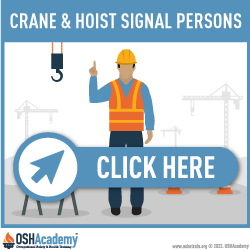Types of Signals
Hand, voice, audible, or new signals are allowed. The type of signals used and means of transmitting the signals to the operator (such as direct line of sight, video, radio, etc.), must be appropriate for the site conditions. All directions given to the operator by the signal person must be given from the operator's perspective.
Hand Signals
This is the most common method of signaling on worksites. When using hand signals, the Standard Method must be used.
Hand signal charts must be either posted on the equipment or conspicuously posted in the vicinity of the hoisting operation.
Voice Signals
Voice Commands
These are signals given by oral communication, with or without amplification or electronic transmission. If this type of signal is used, the operator, signal person, and lift director (if there is one) must, before beginning operations, contact each other and agree on the voice signals that will be used.
Audible Signals
These are signals made by a distinct sound or series of sounds, such as sounds made by a bell, horn, or whistle. As with other types of signals, the signal person and operator must clearly understand the meaning of the signals being used.
New Signal Methods
If appropriate, new methods for signaling may be used such as video monitoring, as long as it meets all OSHA requirements for signaling.
Knowledge Check Choose the best answer for the question.
2-6. What is the most common form of signaling for crane operations on construction sites?
You forgot to answer the question!



